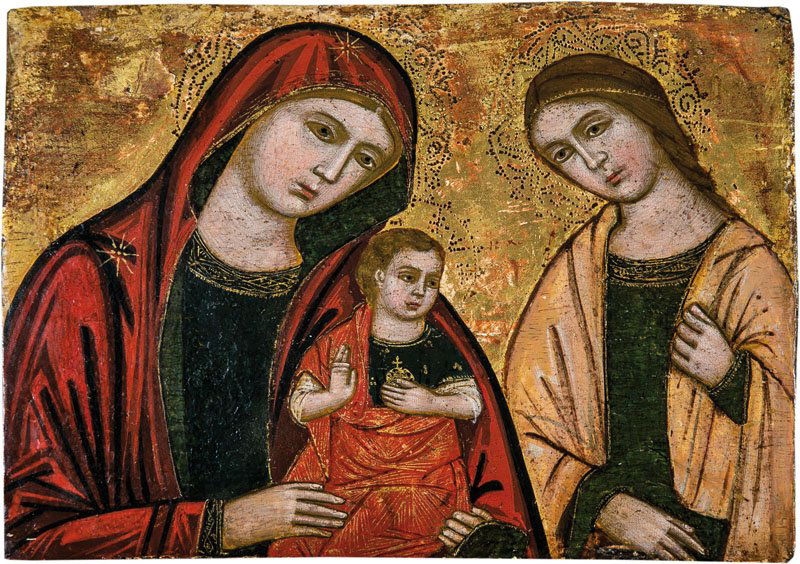
Artist Unknown, Cretan School
Mother of Consolation Veneto-Cretan and Saint Monica, 17th century
Wooden, single panel, Tempera on chalk ground
Gilded background
Embossed haloes
16.5 x 23 cm
Private collection
Image-filling representation of the half-length Mother of God; depicted half-length wearing a blue tunic and a brown maphorion.. She holds the Christ Child in her left arm. He has raised his right hand in blessing and holds with his left the globe. His himation is decorated with a gold-Chrysographie. Next to them, the Saint Catherine appears.
The earliest story tells of Saint Monica in the fourth century, distraught with grief and anxiety for her wayward son, Augustine, confiding her distress to the Mother of God, who appeared to her dressed in mourning clothes, but wearing a shining cincture around her waist. As a pledge of her support and compassion, Our Lady removed the cincture and, giving it to Monica, directed her to wear it and to encourage others to do the same. Monica gave it to her son, who in turn gave it to his community, and so the Augustinian devotion to the wearing of a cincture as a token of fidelity to our Mother of Consolation came into being.
The tradition of praying to the Mother of God for the gift of consolation dates back to the early centuries. The first written evidence of prayer to the Mother of God, Mary, the Theotokos ("Birth-Giver of God" ), is written in Greek on a scrap of Egyptian papyrus dating from between 300-540. In that prayer, she is invoked as the compassionate one More
Saint Monica (AD 331 – 387), also known as Monica of Hippo, was an early Christian saint and the mother of St. Augustine of Hippo. She is remembered and honored in most Christian denominations for her outstanding Christian virtues, particularly the suffering caused by her husband's adultery, and her prayerful life dedicated to the reformation of her son, who wrote extensively of her pious acts and life with her in his Confessions. Popular Christian legends recall Saint Monica weeping every night for her son Augustine.
Cretan School describes an important school of icon painting, which flourished while Crete was under Venetian rule during the late Middle Ages, reaching its climax after the Fall of Constantinople, becoming the central force in Greek painting during the 15th, 16th and 17th centuries. The Cretan artists developed a particular style of painting under the influence of both Eastern and Western artistic traditions and movements; the most famous product of the school, El Greco, was the most successful of the many artists who tried to build a career in Western Europe, and also the one who left the Byzantine style farthest behind him in his later career. More on the Cretan School
Please visit my other blogs: Art
Collector, Mythology, Marine
Art, Portrait of a Lady, The
Orientalist, Art of the Nude and The
Canals of Venice, Middle
East Artists, and 365 Saints, also visit my Boards on Pinterest
Images are copyright of their
respective owners, assignees or others. Some Images may be subject to copyright
I don't own any of these images -
credit is always given when due unless it is unknown to me. if I post your
images without your permission, please tell me.
I do not sell art, art prints, framed
posters or reproductions. Ads are shown only to compensate the hosting
expenses.
If you enjoyed this post, please share
with friends and family.
Thank you for visiting my blog and also
for liking its posts and pages.
Please note that the content of this
post primarily consists of articles available from Wikipedia or other free
sources online.